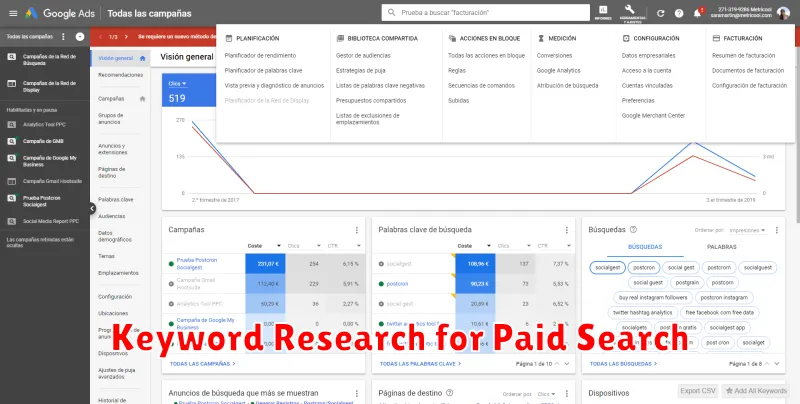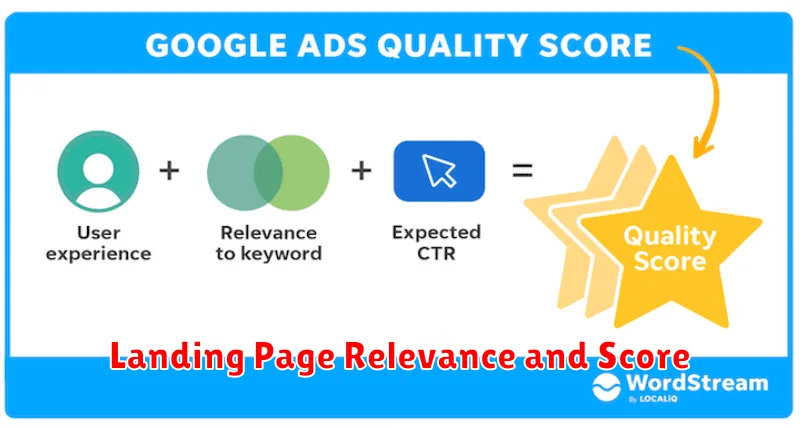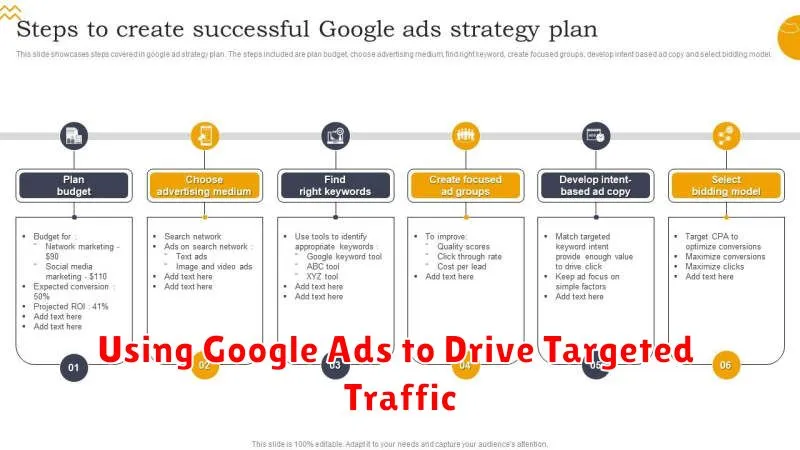Driving targeted traffic to your website is crucial for online success. Are you looking to maximize your return on investment (ROI) and reach the right customers? Google Ads is a powerful platform that enables you to connect with potential customers actively searching for products or services like yours. This article will delve into the intricacies of using Google Ads to effectively drive targeted traffic to your website, exploring strategies for keyword research, campaign setup, and optimization. Learn how to harness the potential of Google Ads to achieve your business goals and boost your online presence.
From understanding the fundamentals of Google Ads to mastering advanced techniques, this comprehensive guide will provide you with the knowledge and tools to create highly effective campaigns. We’ll explore how to identify relevant keywords, craft compelling ad copy, and target specific audiences. By the end of this article, you’ll have a solid understanding of how to leverage Google Ads to drive targeted traffic, increase conversions, and ultimately grow your business. Whether you’re a beginner or an experienced marketer, discover the power of Google Ads to unlock your online potential and reach your target market effectively.
Overview of Google Ads Ecosystem
The Google Ads ecosystem is a complex yet powerful platform for advertisers to reach potential customers. It encompasses a variety of ad formats and networks, allowing businesses to connect with users across Search, Display, Video (YouTube), Shopping, and Discovery campaigns. Each network targets different user behaviors and provides unique opportunities to engage with audiences. For example, Search campaigns target users actively seeking information, while Display campaigns reach users browsing websites across the Google Display Network. Ultimately, the interconnected nature of these networks allows for a comprehensive and highly targeted advertising strategy.
Campaign management within the Google Ads ecosystem revolves around keywords, bids, and targeting. Keywords are the words or phrases that trigger your ads to appear when users search or browse related content. Bids represent the amount you are willing to pay for each click or other desired action. Targeting options allow you to refine your audience based on demographics, interests, location, and other factors. Effective campaign management requires careful consideration of these elements to maximize return on investment (ROI).
Beyond campaign setup and management, the Google Ads ecosystem provides robust measurement and optimization tools. Advertisers can track key performance indicators (KPIs) such as clicks, impressions, conversions, and cost per conversion. This data provides valuable insights into campaign performance and allows for continuous optimization. Through A/B testing, automated bidding strategies, and detailed reporting, advertisers can refine their campaigns to achieve their marketing objectives.
Keyword Research for Paid Search

Keyword research is the foundation of any successful paid search campaign. It involves identifying the terms and phrases that potential customers use when searching online for products or services like yours. Thorough keyword research ensures your ads are shown to the right audience, maximizing your return on investment and minimizing wasted ad spend. Understanding search intent, the reason behind a user’s search, is crucial for selecting relevant keywords that drive conversions. By focusing on the user’s needs, you can create targeted ads that effectively address their queries and lead them further down the sales funnel.
Effective keyword research involves several key steps. Begin by brainstorming relevant terms related to your business. Then, utilize keyword research tools to expand your list and analyze search volume, competition, and relevance. Categorize your keywords into different groups based on themes or search intent, such as informational, transactional, or navigational. This allows for more targeted ad copy and landing page experiences. Continuously monitor and refine your keyword lists based on performance data to optimize your campaigns and stay ahead of the competition.
Choosing the right match types is also essential for effective keyword targeting. Broad match offers the widest reach but can result in irrelevant impressions. Phrase match targets phrases containing your keywords in the specified order. Exact match offers the most precise targeting, showing ads only for searches that exactly match your keywords. Modified broad match offers a balance between reach and relevance. By strategically utilizing different match types, you can fine-tune your targeting and reach the most qualified audience for your products or services.
Setting Up Campaigns and Ad Groups
Campaigns are the foundational structure within online advertising platforms. They represent a single advertising objective, such as driving website traffic or generating leads. Within a campaign, you define your target audience, budget, and overall strategy. Careful planning at the campaign level ensures your advertising efforts remain focused and efficient. Consider factors like geographic targeting, demographics, and the overall goal of your marketing initiatives when structuring your campaign.
Ad groups provide further organization within a campaign, allowing for more granular control over your targeting and messaging. Each ad group should focus on a specific theme or set of keywords related to your overall campaign objective. For example, a campaign focused on selling shoes might have separate ad groups for running shoes, dress shoes, and sandals. This structure allows you to tailor your keywords and ad copy to resonate with specific segments of your target audience, ultimately improving ad relevance and performance.
Effective campaign and ad group structure is crucial for successful online advertising. By organizing your campaigns around clear objectives and segmenting your ad groups by specific themes, you can maximize your budget and achieve your desired results. This structure helps improve Quality Score, leading to lower costs and better ad positioning.
Writing High-Performing Ad Copy
Creating effective ad copy requires a clear understanding of your target audience and their needs. Focus on highlighting the key benefits of your product or service and how it solves a specific problem for them. Use concise and persuasive language to capture their attention and encourage them to take action. Testing different versions of your ad copy is crucial for optimizing performance and maximizing your return on investment.
A strong call to action is essential for driving conversions. Tell your audience exactly what you want them to do, whether it’s visiting your website, making a purchase, or signing up for a newsletter. Use action-oriented verbs like “Shop Now,” “Learn More,” or “Get Started” to create a sense of urgency and encourage immediate action. Keep your message focused and relevant to the specific offer you’re promoting.
Finally, ensure your ad copy aligns with your overall brand messaging and maintains a consistent tone. Consider the platform where your ad will be displayed and tailor your language accordingly. For example, ad copy for social media may be more informal than copy for a search engine ad. Regardless of the platform, always prioritize clarity, conciseness, and a compelling value proposition.
Landing Page Relevance and Score

Landing page relevance measures how well a landing page content aligns with the user’s search query or the ad that brought them there. A highly relevant landing page provides a seamless user experience, offering exactly what the user expects to find. This positive user experience signals to search engines that the page is a good match for the query, leading to a higher quality score and potentially improved ad rankings. Conversely, a low relevance score can negatively impact ad performance and potentially increase advertising costs.
Several factors contribute to a landing page’s relevance score. Keyword usage on the page plays a crucial role, indicating the page’s topic to search engines. However, keyword stuffing should be avoided, as it can be detrimental. The page’s content should accurately reflect the promises made in the ad or suggested by the search query. Clear and concise messaging that directly addresses the user’s needs is essential. Finally, a user-friendly design with easy navigation contributes to a positive user experience and, in turn, a higher relevance score.
Improving landing page relevance requires careful consideration of the target audience and their search intent. Thorough keyword research can help identify the terms users are searching for. Creating targeted content that directly addresses those terms and provides valuable information is key. Ensuring a consistent message between the ad and the landing page is also critical. Regularly testing and optimizing the landing page based on user behavior can further enhance its relevance and improve overall performance.
Targeting by Location and Device
Targeting by location and device allows advertisers to focus their campaigns on specific geographic areas and the devices people use to access the internet. Location targeting can be as broad as a country or as narrow as a specific zip code. This allows businesses to tailor their messaging to local audiences or concentrate their efforts in areas with the highest potential return. Device targeting, on the other hand, lets advertisers choose whether their ads appear on desktops, mobile phones, tablets, or other connected devices. This is crucial for optimizing ad creatives and landing pages for the best user experience.
By combining location and device targeting, advertisers can create highly effective campaigns. For example, a restaurant could target mobile users within a five-mile radius with special lunch promotions. Or, a software company could target desktop users in a specific city known for its tech industry with ads for their latest product. This level of granularity ensures that ads are shown to the right people at the right time, maximizing the impact of the advertising budget.
Benefits of targeting by location and device include increased relevance, improved conversion rates, and better return on investment (ROI). By showing ads only to users who are likely to be interested in the product or service, advertisers can avoid wasting ad spend on irrelevant impressions. This leads to higher click-through rates, more conversions, and ultimately, a more successful advertising campaign.
Using Extensions for Better Clicks

Browser extensions can significantly improve your online experience, especially when it comes to clicks. They can automate tasks, enhance website navigation, and even improve click-through rates for marketing campaigns. Choosing the right extensions is crucial for maximizing their benefits.
Some popular types of extensions that enhance clicks include: auto-clickers for repetitive tasks, link shorteners for cleaner marketing materials, and website navigators that streamline webpage interaction. Be mindful when installing extensions, prioritizing reputable sources to avoid malware and ensuring they align with your specific needs.
By carefully selecting and utilizing browser extensions, you can optimize your clicks for greater efficiency and productivity. Remember to regularly review and manage installed extensions to ensure optimal browser performance.
Analyzing Performance Metrics
Analyzing performance metrics is crucial for understanding how well a system, process, or individual is performing against established goals. These metrics provide quantifiable data that can be used to identify strengths, weaknesses, and areas for improvement. By tracking metrics over time, trends can be identified, allowing for proactive adjustments and informed decision-making. Common examples of performance metrics include key performance indicators (KPIs), return on investment (ROI), and customer satisfaction scores.
The process of analyzing performance metrics involves several key steps. First, relevant metrics must be identified based on the specific goals and objectives. Data related to these metrics should then be collected and validated to ensure accuracy. Next, the data is analyzed using various techniques such as statistical analysis, trend analysis, and comparative analysis. Finally, the results of the analysis are interpreted to draw meaningful conclusions and identify actionable insights.
Effective analysis of performance metrics allows organizations to optimize resource allocation, improve efficiency, and enhance overall performance. It provides a data-driven approach to problem-solving and helps ensure that efforts are aligned with strategic objectives. Regular monitoring and analysis of metrics are essential for continuous improvement and achieving long-term success.
Split Testing Ad Variants
Split testing, also known as A/B testing, is a crucial method for optimizing your advertising campaigns. It involves running two or more versions of your ad simultaneously to determine which performs best. By showing different variations to similar audiences, you can gather data on key metrics like click-through rates, conversion rates, and cost-per-click, allowing you to identify the most effective elements for your target audience.
The process typically involves changing one element at a time, such as the headline, image, or call to action. This isolated approach allows you to pinpoint exactly which modification leads to improved performance. For instance, you might test two headlines with different wording or two images with different subjects to see which resonates more with your audience. Analyzing the results will reveal the winning variant, empowering you to refine your ads for maximum impact.
Split testing is an ongoing process. As your target audience evolves and market trends shift, continuous testing ensures your ads remain relevant and effective. By regularly experimenting with new variations, you can stay ahead of the curve and optimize your campaigns for long-term success.
Budgeting and Scaling Tips
Budgeting is crucial for any business, especially startups. Start by identifying your fixed costs (rent, salaries) and variable costs (marketing, materials). Track your spending diligently and look for areas where you can reduce expenses without sacrificing quality. Prioritize spending on activities that directly contribute to revenue generation. Regularly review and adjust your budget as your business grows and evolves.
Scaling your business requires careful planning and execution. Focus on sustainable growth rather than rapid expansion. Identify your key performance indicators (KPIs) and track them closely to measure your progress. Ensure you have the necessary infrastructure in place, including technology, personnel, and processes, to support increased demand. Consider automating tasks where possible to improve efficiency and reduce costs.
As you scale, don’t lose sight of your core values and customer needs. Maintain open communication with your team and customers to ensure everyone is on board with the changes. Be prepared to adapt your strategy as needed and don’t be afraid to pivot if necessary. Remember that sustainable scaling is a marathon, not a sprint.

